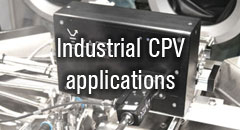In-situ metrology for Concentrated Photovoltaics (CPV)

In concentrated photovoltaics, high efficiency of up to 44% can be achieved nowadays with multi-junction solar cells based on III-V compound semiconductor materials. Sunlight collected from a large area is focused on small area solar cells. LayTec in-situ metrology systems enable you to follow all the process steps during MOCVD or MBE growth of multi-layer solar cell structures. These systems monitor:
• Layer thickness and growth rate
• Surface morphology
• Surface stoichiometry
• Film strain and wafer bowing
• Film composition
• True wafer temperature
• Doping concentration
and other key parameters.

For industrial CPV applications, robust analysis of the growth combined with a real-time statistical process control is needed. For industrial requirements, LayTec’s EpiTT and EpiCurve® TT product families in combination with the EpiGuard® software packageare applied. These in-situ systems provide a comprehensive and robust monitoring of growth parameters. Emissivity corrected pyrometry (ECP) has become the backbone of these metrology systems because crystalline quality, composition, and doping level highly depend on wafer surface temperature as it is measured on III-V, Si or Ge substrates by LayTec’s integrated ECP modules.
The second key to high performance CPV epitaxy is the precise thickness monitoring of all layers during growth. Simultaneous reflectance measurement at 405 nm, 633 nm and 950 nm provide information on layer thickness, surface morphology and interface quality. In particular the shorter wavelength (405 nm) is widely used for characterization of AlInP process window already during the process.
A further critical parameter is the wafer bow during and after growth. The heteroepitaxy of the III-V compounds on Ge leads to a significant bow of the wafer. It was found that the curvature in these applications is strongly aspheric after intentioned buffer relaxation for metamorphic growth. LayTec’s advanced resolution (AR) curvature technology enables the user to distinguish between spherical curvature and asphericity. The resulting signal helps to optimize the buffer growth and its relaxation at early and decisive stages of the epitaxial process.

For research and development of concentrated multi-junction solar cells, a direct real-time access to interface stoichiometry and doping levels is indispensable for deep understanding of the effects that occur during the epitaxial growth. This kind of control is possible with Reflectance Anisotropy Spectroscopy (RAS) – an optical method applied in LayTec’s EpiRAS® TT. One of the technological challenges is the growth of low defect III-V semiconductor structures on co-valent group IV Ge substrates. Here, EpiRAS® TT helps control key growth parameters of the heterostructures throughout MOCVD process. The metrology system enables avoiding initial antiphase boundary formation at the III-V of Ge interface and provides wide-range spectral reflection measurements to determine ternary composition and growth rate, RAS signal to measure the doping level and, last but not least, the emissivity corrected pyrometry for an accurate temperature monitoring. ...more
Boosting triple-junction yield with in-situ monitoring
Compound Semiconductor Magazine published an article that reports about the application of LayTec’s in-situ metrology tools for development and production of concentrator photovoltaic cells. Follow this link to read the article
In-situ benefits for CPV
LayTec's in-situ tools will help you
- fasten your process optimization and R&D cycles
- increase cell efficiency to 44%
- control the bow of GaAs/InP to improve the later processing yield
- analyze lattice matched structures both at room and process temperature
- optimize AlInP process window already during growth
In our CPV Application Note you will find detailed information and measurement examples of our customers.
For industrial applications
- dependance of crystalline quality, composition, and doping level on wafer surface temperature
- precise monitoring of thickness, surface morphology and interface quality of all layers during growth
- bow measurements for strain management including asphericity measurements
- optimization of the buffer growth and its relaxation at early and decisive stages of the epitaxial process
For multi-junction solar cell development
- avoiding initial antiphase boundary formation at the III-V of Ge interface
- determination of ternary composition, interface quality, growth rate and doping level

